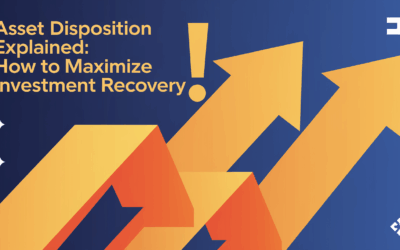Optimizing Asset Disposition: Strategies for Maximizing Efficiency and Returns
Asset disposition is not only crucial for optimizing operational efficiency and profitability but is also an integral part of tax reporting. Taxable dispositions, non-taxable dispositions, and involuntary conversions help evaluate the amount of taxable loss or gain on an asset. Each asset disposition type has its defined rules and reporting requirements to ensure compliance with the stipulated Internal Revenue Service or IRS regulations. Hence, by gaining a better understanding of asset disposition, organizations can make informed decisions, aligned with their strategic objectives.
Let’s understand more about asset disposition and how you can use effective strategies to stay ahead.
Understanding Asset Disposition
Every company has assets, such as machinery, IT assets, equipment, technology, or real estate that support operations and help generate revenue. However, companies can consider asset disposition when these assets reach the end of life, are no longer useful, become obsolete or outdated, or encounter any unforeseen circumstances.
Asset disposition is the process of managing the end-of-life assets within an organization, including sale, recycling, or disposal. This strategic practice is crucial for organizations that are looking to optimize their operations, effectively handle their resource allocation, and improve the bottom line.
It is not only about removing assets from the company’s balance sheet to maintain accurate account records; it also involves capturing any residual value from these assets. This helps minimize costs associated with holding them and also ensures compliance with legal and environmental regulations during disposal or recycling.
What Are Different Asset Disposition Methods
Some of the common methods of asset disposition include the following.
- Selling: Assets can be sold through auctions, online marketplaces, or private sales to recover value. This method usually works well for assets that still have market value.
- Recycling: The recycling method works best for assets that cannot be sold or are environmentally sensitive. It helps dispose of assets responsibly while complying with environmental regulations.
- Donating: Organizations may often donate assets to non-profit organizations or educational institutions. This method can, thus, provide tax benefits while supporting community initiatives.
- Repurposing within the organization: Some assets can be repurposed or reused in other departments or projects within the same organization.
- Trade-ins: Some companies may opt for trade-in deals when purchasing new equipment. In this method, old assets can be exchanged for credit toward new purchases.
- Physical destruction: For assets that contain sensitive data or intellectual property, physical destruction can help ensure that information cannot be recovered or misused.
What Does the Asset Disposition Process Look Like
Here’s a quick look at the steps involved in asset disposition.
- Identify assets: In this initial step, identify redundant, obsolete, or minimally used assets. It helps you evaluate and decide which assets to divest or repurpose.
- Explore disposal strategies: You need to assess various disposal methods, such as auctions, direct sales, or recycling, to pim down the most profitable approach. Consider the benefits, limitations, and logistics of each option to choose the best one.
- Ensure data privacy: Undoubtedly, data protection is critical during asset disposal. You need to prioritize data security by securely erasing or physically destroying data on devices to prevent any unauthorized access or breach.
- Uphold environmental regulations: It is important that you comply with environmental regulations during asset disposal. You can utilize certified recyclers or refurbishment programs that help extend the lifecycle of assets in an environmentally responsible way.
- Optimize asset value: The ultimate aim of asset disposal is to recover as much value as possible and maximize financial returns from asset disposition. You can consider conducting market research, benchmarking competitive prices, and utilizing online platforms to optimize asset value.
Determining Gain or Loss on Disposal of Assets
Here are some of the basic steps that can help you determine gain or loss on the disposal of fixed assets.
Determine the Book Value
The book value of an asset is its original cost minus the accumulated depreciation credit balance. This represents the net value of the asset on the company’s books at the time of disposal.
Compare Book Value to the Value Received in Return for the Asset
Compare the value received from disposing of the asset to its book value to determine if there is a gain, a loss, or a breakeven scenario. Consider the following.
- Discard: If the asset is discarded and nothing is received in return, the loss is equal to the book value of the asset. If the asset’s book value is already zero, discarding it results in a break-even.
- Sale: When the asset is sold for cash, compare the cash received to the book value of the asset. It will indicate whether there is a gain (cash received > book value), a loss (cash received < book value), or a break-even (cash received = book value).
- Exchange (trade-in): If the asset is traded in for a similar asset, the trade-in allowance (value given for the old asset) is compared to its book value. A gain occurs if the trade-in allowance > book value, a loss if it’s less, and breakeven if equal.
Journal Entry
The accounting journal entry to record the disposal starts by removing the asset and its accumulated depreciation from the books:
- Credit the fixed asset account for its original cost to remove it from the books.
- Debit the accumulated depreciation account to remove the depreciation associated with the asset.
- For a sale, debit cash for the amount received.
- For an exchange, debit the new asset account for the fair market value or trade-in value received.
- If there’s a loss (book value > value received), debit the loss on the disposal of the asset account to recognize the loss.
- If there’s a gain (value received > book value), credit the gain on disposal of the asset account to recognize the gain.
Challenges and Risks in Asset Disposition
In the initial stages of asset disposition, it’s essential to identify and evaluate the risks associated with the process. This involves examining multiple aspects, including market dynamics, regulatory guidelines, and complex business operations. You also need to have a deep understanding of other possible hurdles, like legal obligations, financial repercussions, and environmental issues. Companies can formulate an all-encompassing strategy to address and mitigate these risks efficiently following a detailed assessment of these risks.
Best Practices for Asset Disposition
By adhering to the following best practices, you can effectively manage the complexities of asset disposition.
Formulate a Strategic Plan
After identifying potential risks, craft a strategic blueprint for your asset disposition process. Make sure to factor in your company’s objectives, current market trends, and financial limitations, offering a comparison of various disposal methods—be it individual sales, liquidation, or repurposing. For instance, the sale of outdated IT equipment as individual pieces might yield higher returns, whereas bulk liquidating a fleet of vehicles could be a more effective option.
Collaborate with Specialists
You may need to consider working with professionals when navigating the complex landscape of asset disposition. When you engage with experts, whether real estate evaluators or environmental consultants, they ensure the process is conducted smoothly and in compliance with legal and regulatory standards.
Adopt Risk Mitigation Measures
To reduce potential risks, implement targeted strategies. This includes securing the necessary permits, conducting due diligence, and adhering to all required regulations. For instance, for assets containing hazardous materials, it is critical to comply with environmental laws to uphold the organization’s reputation and mitigate any adverse effects.
Aim for Continuous Monitoring and Assessment
You need to proactively monitor your asset disposition process to detect and address any unforeseen issues. Regular evaluation can help you adjust strategies in response to dynamic market conditions. This can ultimately help increase returns and reduce losses.
Final Words
A holistic approach toward asset disposition not only ensures legal and environmental compliance but also optimizes financial returns. A deep understanding and application of asset disposition strategies can help organizations achieve strategic goals and gain a competitive edge in the business landscape.



